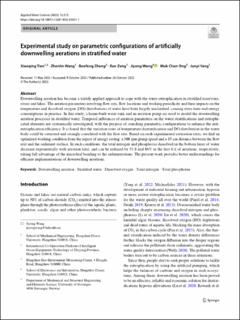| dc.contributor.author | Tian, Xiaoqing | |
| dc.contributor.author | Wang, Zhenlin | |
| dc.contributor.author | Zhang, Baofeng | |
| dc.contributor.author | Zeng, Ran | |
| dc.contributor.author | Wang, Jiyong | |
| dc.contributor.author | Ong, Muk Chen | |
| dc.contributor.author | Yang, Junyi | |
| dc.date.accessioned | 2024-02-22T10:24:14Z | |
| dc.date.available | 2024-02-22T10:24:14Z | |
| dc.date.created | 2023-11-09T12:33:44Z | |
| dc.date.issued | 2023 | |
| dc.identifier.citation | Tian, X., Wang, Z., Zhang, B., Zeng, R., Wang, J., Ong, M. C., & Yang, J. (2023). Experimental study on parametric configurations of artificially downwelling aerations in stratified water. Applied Water Science, 13(11), 215. | en_US |
| dc.identifier.issn | 2190-5487 | |
| dc.identifier.uri | https://hdl.handle.net/11250/3119271 | |
| dc.description.abstract | Downwelling aeration has become a widely applied approach to cope with the water eutrophication in stratified reservoirs, rivers and lakes. The aeration parameters involving flow rate, flow locations and working periodicity and their impacts on the temperature and dissolved oxygen (DO) distributions of water have been largely unclarified, causing extra time and energy consumptions in practice. In this study, a home-built water tank and an aeration pump are used to model the downwelling aeration processes in stratified water. Temporal influences of aeration parameters on the water stratifications and eutrophicated elements are systemically investigated, with the purpose of searching parametric configurations to enhance the anti-eutrophication efficiency. It is found that the variation rates of temperature destratification and DO distribution in the water body could be saturated and strongly correlated with the flow rate. Based on such experimental saturation rates, we find an optimized working condition from the aspect of energy saving: a 300 rpm pump speed and a 15 cm distance between the flow exit and the sediment surface. In such conditions, the total nitrogen and phosphorus dissolved in the bottom layer of water decrease exponentially with aeration time, and can be reduced by 53.8 and 86% in the first 6 h of aerations, respectively, taking full advantage of the microbial bonding to the sedimentations. The present work provides better understandings for efficient implementations of downwelling aerations. | en_US |
| dc.language.iso | eng | en_US |
| dc.publisher | Springer | en_US |
| dc.rights | Navngivelse 4.0 Internasjonal | * |
| dc.rights.uri | http://creativecommons.org/licenses/by/4.0/deed.no | * |
| dc.title | Experimental study on parametric configurations of artificially downwelling aerations in stratified water | en_US |
| dc.type | Peer reviewed | en_US |
| dc.type | Journal article | en_US |
| dc.description.version | publishedVersion | en_US |
| dc.rights.holder | The authors | en_US |
| dc.subject.nsi | VDP::Teknologi: 500::Miljøteknologi: 610 | en_US |
| dc.source.volume | 13 | en_US |
| dc.source.journal | Applied water science | en_US |
| dc.source.issue | 11 | en_US |
| dc.identifier.doi | 10.1007/s13201-023-02021-1 | |
| dc.identifier.cristin | 2194523 | |
| cristin.ispublished | true | |
| cristin.fulltext | original | |
| cristin.qualitycode | 1 | |

